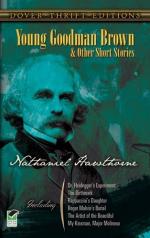|
This section contains 8,272 words (approx. 28 pages at 300 words per page) |

|
SOURCE: “‘Young Goodman Brown’ and Hawthorne's Theory of Mimesis,” in Nineteenth-Century Fiction, Vol. 23, No. 4, March, 1969, pp. 393-412.
In the following essay, Stoehr examines “Young Goodman Brown” in light of Hawthorne's ideas on the relationship between spiritual and natural truth, and the dangers implicit in confusing the two.
The tellers of tales—in America, writers like Poe, Hawthorne, Melville, and later Mark Twain—construct their fictions around some single and striking figure of speech, at once abstract and concrete, an idea embodied in an action, object, circumstance, or the like, so that it becomes, as it were, a trope of life. The tale's main “effect”—to use Poe's term for it—reduces again and again to some bizarre image: a house collapsing with the death of its owner, a woman dying with the removal of her birthmark, a stutterer whose speech is act, a package of limburger cheese mistaken...
|
This section contains 8,272 words (approx. 28 pages at 300 words per page) |

|


